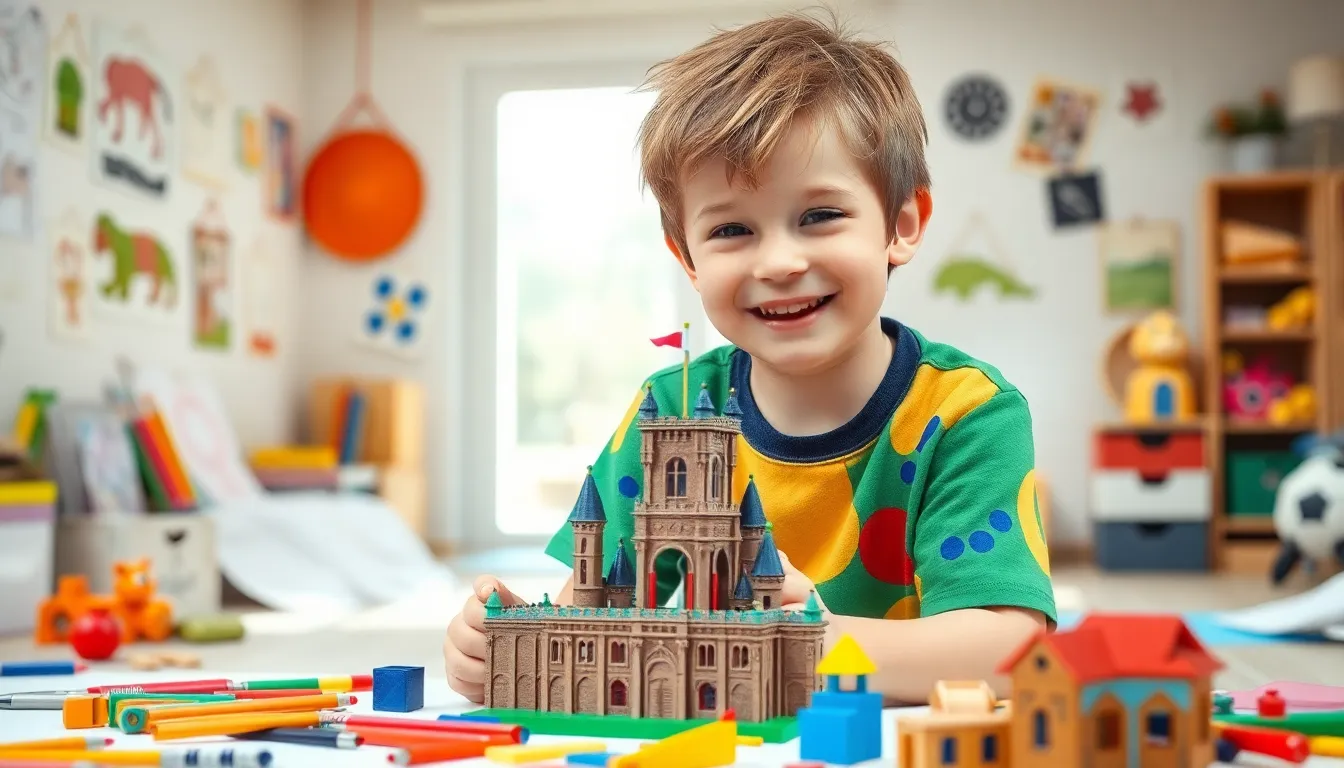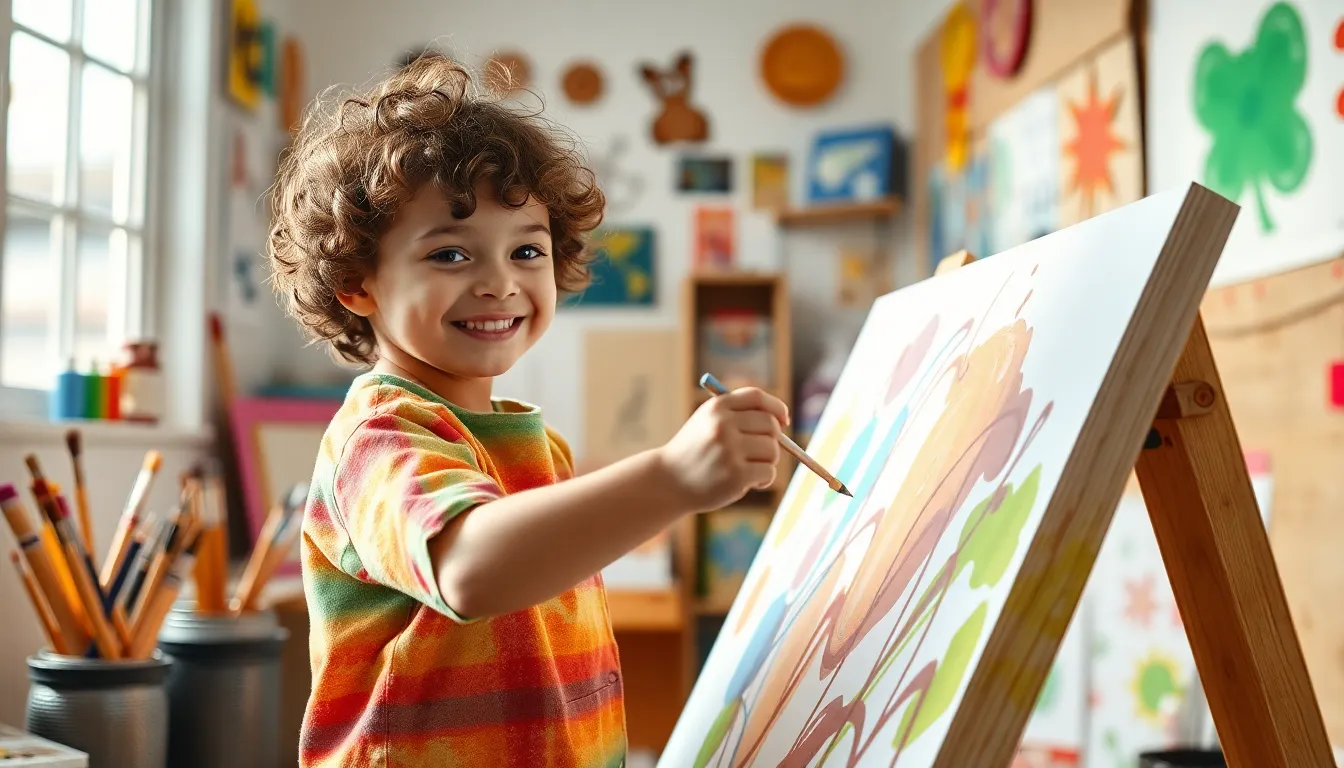Every parent dreams of raising a creative genius, but what if that genius has a knack for turning the living room into a makeshift art studio? Creative kids have a unique ability to see the world through a kaleidoscope of imagination, often leading to delightful messes and unexpected masterpieces. They’re the little Picassos who can turn a cardboard box into a spaceship or a pile of crayons into a new fashion trend.
Encouraging creativity isn’t just about making art; it’s about nurturing problem-solving skills and boosting confidence. So, how can parents cultivate this imaginative spirit without losing their sanity—or their furniture? Buckle up for a fun ride through the whimsical world of creative kids, where laughter meets learning, and every day is an adventure waiting to unfold.
Table of Contents
ToggleUnderstanding Creative Kids
Creative kids express themselves through vivid imagination and innovative ideas. They see the world differently, turning mundane objects into sources of inspiration.
Defining Creativity in Children
Creativity in children involves the ability to generate original ideas and solutions. It manifests in various forms, such as art, music, storytelling, or imaginative play. This unique trait encourages them to explore new concepts and perspectives. Children often combine existing elements in novel ways, showcasing their inventive spirit. Opportunities for creative expression allow them to experiment and discover their preferences. Observing a child’s creative output can reveal valuable insights into their individual personality and interests.
The Importance of Creativity in Development
Nurturing creativity in children supports their cognitive growth and emotional resilience. Engaging in creative activities enhances critical thinking and problem-solving skills. Kids learn to approach challenges with an open mind and flexible thinking. Creativity also fosters self-confidence, as children take pride in their creations and artistic endeavors. Developing this skill contributes to effective communication and collaboration with peers. Early exposure to creative opportunities lays the foundation for lifelong learning and adaptability. Overall, creativity plays a crucial role in shaping well-rounded, capable individuals.
Characteristics of Creative Kids

Creative kids often exhibit distinct traits that set them apart. They demonstrate a remarkable ability to think outside the box, finding joy in imaginative activities.
Imagination and Playfulness
Imagination fuels creative kids. They explore hypothetical scenarios and make-believe worlds with ease. Engaging in role-playing games, they craft stories and characters that reflect their unique perspectives. Often, they transform simple spaces into elaborate settings, showcasing their playful nature. Through imaginative play, kids express emotions and solve problems in innovative ways. Playfulness enhances social interactions, allowing them to collaborate on projects with peers. Creativity thrives in environments where imagination is nurtured, enabling kids to dream without limitations.
Problem-Solving Skills
Creative kids possess strong problem-solving skills. They approach challenges with an open mind, viewing obstacles as opportunities for innovation. Finding multiple solutions, they analyze situations from various angles. Critical thinking skills emerge as they navigate through problems, often applying creative strategies to reach outcomes. These children frequently exhibit resilience, adapting their ideas when initial ones don’t work. They learn to embrace failure as part of the creative process, building confidence in their ability to think critically. Nurturing problem-solving skills fosters independence and equips kids for future endeavors.
Encouraging Creativity in Kids
Encouraging creativity in kids plays a crucial role in their development. Engaging in specific activities can spark imagination and enhance their skills.
Activities That Foster Creativity
Arts and crafts stimulate kids’ creativity. Building with LEGO blocks encourages them to think outside the box. Writing stories or poems allows for self-expression and storytelling. Experimenting with music, whether through instruments or singing, cultivates a sense of rhythm and creativity. Nature walks inspire scavenger hunts, prompting kids to observe their environment and draw inspiration. Cooking together provides a hands-on opportunity to explore flavors and textures, fostering creativity in the kitchen.
The Role of Environment
A nurturing environment significantly influences kids’ creativity. Open spaces filled with art supplies promote exploration and experimentation. Creating a designated creative zone in the house offers kids room to create without constraints. Incorporating natural light enhances mood and inspires artistic projects. Surrounding children with diverse books and materials exposes them to a variety of ideas. Encouragement from parents and caregivers boosts confidence, allowing kids to embrace their creative instincts.
Challenges for Creative Kids
Creative children face unique challenges that can hinder their expression and acceptance. Many kids struggle with environments that limit their self-expression, leading to frustration and disengagement. Parents can help by creating safe spaces where children can explore their ideas without judgment. Providing diverse materials fosters a sense of freedom, inspiring kids to engage more fully with their creativity.
Overcoming Barriers to Expression
Barriers often arise from rigid structures in education and social settings. Teachers might prioritize standardized assessments over creative projects, stifling original thought. Supportive adults can combat this by emphasizing process over product, encouraging experimentation. Open conversations about feelings can also empower creative kids to express themselves. Encouragement from parents and teachers significantly boosts confidence, helping kids navigate challenges effectively.
Addressing Misconceptions About Creativity
Misconceptions surrounding creativity often paint it as a talent exclusive to a few. Many people believe creativity only manifests in the arts, overlooking its presence in science and problem-solving. Highlighting diverse forms of creativity reveals its broader applicability, showcasing how it enhances all skills. Education systems can promote this understanding, fostering a culture that values creativity in multiple disciplines. Shifting perspectives helps validate the creative process, allowing children to embrace their uniqueness.
Nurturing creative kids is essential for their overall development. By fostering their imaginative spirit parents can help these children thrive in various aspects of life. Providing opportunities for exploration and self-expression not only enhances their creativity but also builds vital skills like problem-solving and resilience.
Creating an environment that encourages artistic endeavors allows children to embrace their unique perspectives. When parents actively support and engage in creative activities with their kids it strengthens their bond and boosts confidence. Understanding the challenges these children face empowers parents to advocate for their needs and promote creativity in all its forms.
Ultimately raising creative children means celebrating their individuality and encouraging them to view the world through a lens of imagination. This approach lays the groundwork for a future filled with innovation and self-assuredness.



